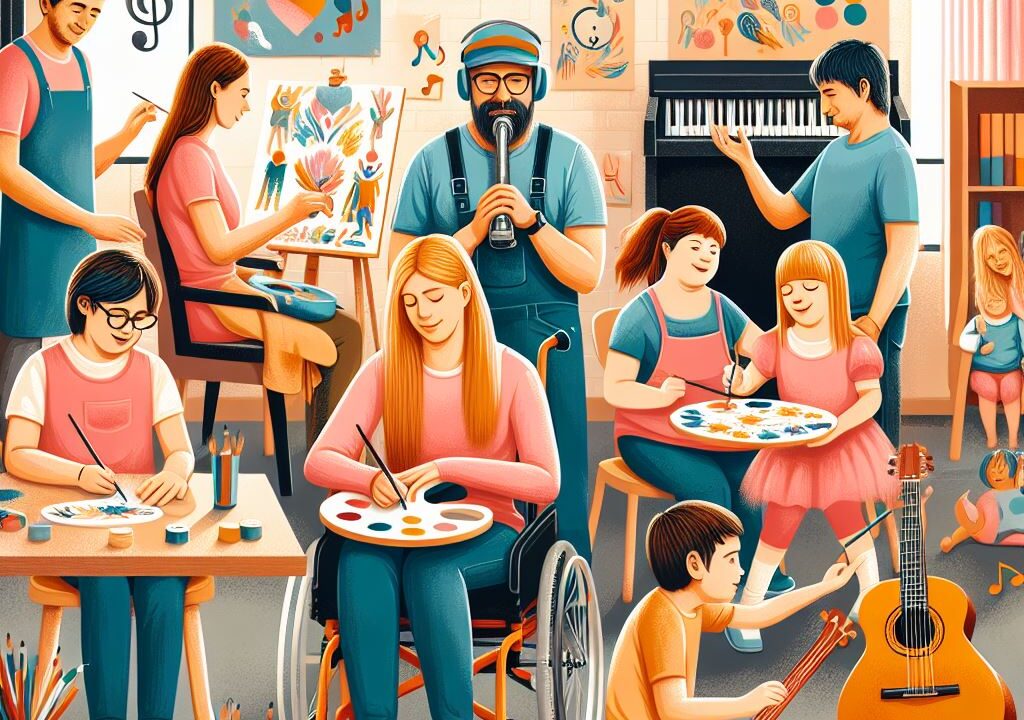Introduction
In the realm of helping people who have disabilities, we’re more than just discussing the need to fix physical problems. The focus is on the big picture and using various methods to assist, including artistic therapies such as art therapy and music. This blog looks at how art and music can have a significant impact to the lives of those who are disabled and help them feel more comfortable and more at ease.
Understanding Music Therapy
Music is a universal language that everybody understands. It can help you feel certain things, recollect memories, and connect to others. Music therapy makes use of the power of rhythm and sound to aid people who have disabilities. You can play instruments or sing, or listen, it is an important factor for those with diverse challenges and disabilities.
Expressing Feelings
Music is an excellent method of expressing your feelings, especially when words are difficult to come by. Music therapy helps people to express and understand their feelings, creating peace and less stress.
Getting Smarter
Music playing can help your brain function better. It aids in concentration, memory and problem-solving. It is particularly helpful for those suffering from cognitive impairments. The music and rhythm are an enjoyable exercise on the brain.
Moving Better
Engaging in music or dancing to the beat can enhance physical capabilities. For people who have physical limitations music therapy can be an effective way to increase balance, coordination, and strength.
Making Friends
Music therapy doesn’t have to be just about the music. It’s a chance for you to interact with other people, form friendships and not be lonely. It creates a sense of community and social connections.
Unleashing Creativity: Art Therapy
The art therapy, just like music is a way to tap to the expressive potential of another language, which is visual art. Making art is a method to express oneself and communicate. Let’s look at how art therapy can contribute to the overall wellbeing of those with disabilities.
Expressing Without Words
Art is a language that can help people with difficulties speaking. Through drawing, painting or sculpting, people who have disabilities can speak beyond the limitations of traditional languages.
Feeling Proud
Artwork lets people feel proud of their work which boost confidence and self-esteem. The completion of an artwork is an achievement, honoring your unique skills.
Beating the Tough Times
Art therapy offers a secure place to process and explore difficult emotions. The act of creating art is an outlet for relaxation, and helps deal with emotional stress and difficulties.
Using Senses
Artmaking stimulates the senses and is especially beneficial for those suffering from sensory processing issues. The tactile sensation of crayons or paint creates a structured, yet fluid environment that allows for exploration of the senses.
Incorporation into Disability Care Programs
Recognizing how beneficial art therapy and music can be, numerous disability-related services integrate these methods in their overall care plans. In rehabilitation centers or residential care facilities or in community-based programs they can improve your overall experience of the care.
Tailored Programs for Diverse Needs
The highly trained music and art therapists collaborate closely with each client to design individualized programs that meet their individual requirements. This approach is tailored to ensure that the benefits of music therapy and art are maximized for every person.
Collaboration with healthcare professionals
Therapists of music and art often collaborate with healthcare professionals, such as psychologists and doctors to design complete care plans. This collaboration tackles both physical and emotional aspects in creating a healthy atmosphere.
Inclusive Community Engagement
Disability care programs extend beyond individual therapy and involve organizing groups and community activities. They showcase the creativity of those who participate, recognizing their talents and encouraging a greater understanding of the community.
Conclusion
In the field of disability-related care music therapy and art therapy tell the impression of self-expression, empowerment, and general healing. Beyond their aesthetics the arts and music serve as powerful tools to improve the development of emotional balance, communication and physical growth. As the demand for disability services increases by integrating these therapies, it helps people with disabilities not just receive medical care but also benefit from the transformative impact of their artistic expression. With therapists, healthcare professionals and people who work together, the orchestra of healing continues to create an enlightened as well as more welcoming futures for everyone.

